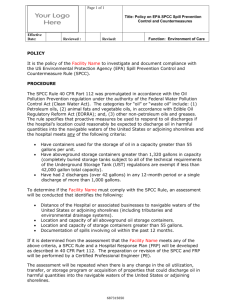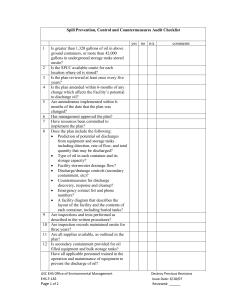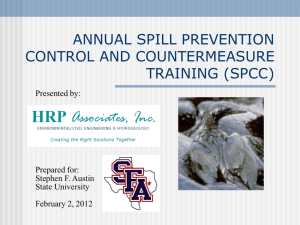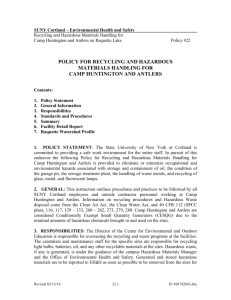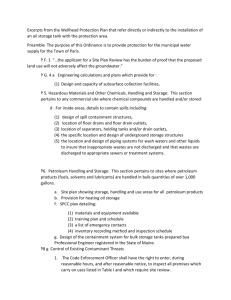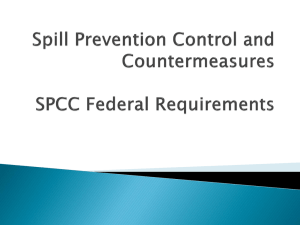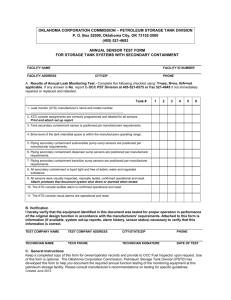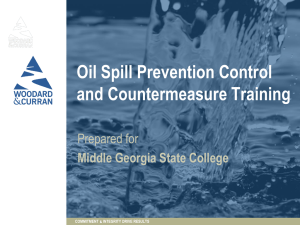US EPA Region 7 Oil Spill Prevention and Response
advertisement
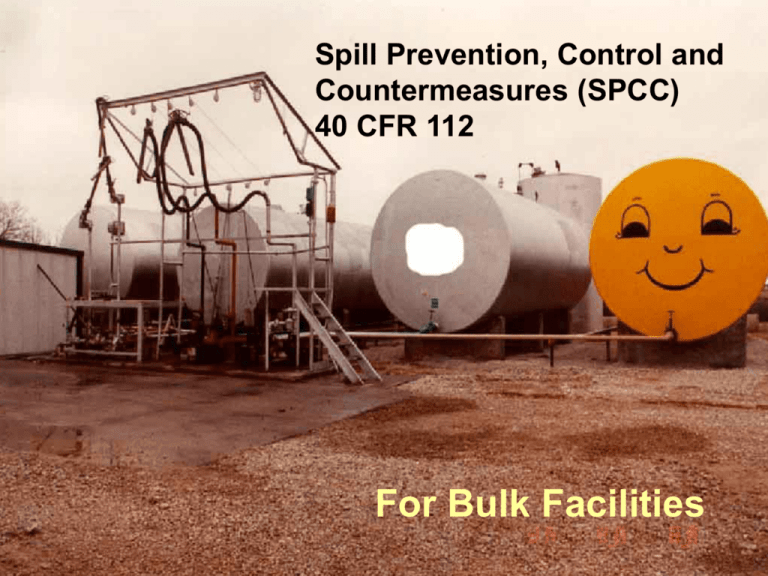
Spill Prevention, Control and Countermeasures (SPCC) 40 CFR 112 For Bulk Facilities SPCC Rule/Regulation – What Will Be Covered Overview of the Oil Pollution Prevention Rules, Who Needs an SPCC Plan, Requirements for Preparing, Implementing and Changing an SPCC Plan, Inspections, Tests, and Records Training Requirements, Security Requirements Loading/Unloading Areas, Facility Drainage, Bulk Storage Containers, Secondary Containment/Dikes, Berms, etc., Transfer and Process Operations: pipes and pumps, Oil Pollution Prevention Rule Published in the Federal Register on July 17, 2002 Became effective August 16, 2002 Extended 18 months on April17, 2003 Title 40 Code of Federal Regulations, Part 112 Requires certain oil storage facilities to prepare a Spill Prevention, Control and Countermeasures Plan or SPCC Plan Do you have an oil? The list of Petroleum and Non-petroleum oils subject to the Clean Water Act requirements can be found at “http://www.uscg.mil/vrp/faq/oil.shtml” Oils include: gasoline, non-petroleum oils, asphalt, hexane, jet fuel, mineral spirits, edible and nonedible animal and vegetable oils, coal tar, creosote, lube oil additives, tallow, polyolefins, ethyl cyclohexane, turpentine,……... SPCC Applicability (112.1) Non-Transportation-Related Facility engaged in: Drilling, producing, gathering, storing, processing, refining, transferring, distributing, using, or consuming Oil of any kind (petroleum, vegetable, animal, synthetic) in: Total aboveground storage capacity >1,320 gallons counting only containers 55 gallons and greater; and/or Total underground capacity > 42,000 gallons not including capacity of buried tanks covered in 40 CFR part 280 or 281 Exempts wastewater treatment facilities SPCC Applicability (112.1) continued A discharge of oil from the facility could reasonably be expected to reach waters of the U.S., Dikes, equipment, and other manmade structures are not considered as reasons that oil would not be expected to reach waters of the U.S., Examples of waters of the U.S. may include: lakes, rivers, streams, dry creek beds, ditches, wetlands, and tributaries to these. OPA Jurisdiction of Federal Agencies SPCC Applicability (112.1) Waters of U.S. SPCC Requirements for Preparation and Implementation (112.3) Facilities Prior to August 16, 2002 – Must have a revised plan by August 17, 2004. The revised plan must be implemented by February 18, 2005. Facilities after August 16, 2002 – Must have a plan and the plan must be implemented on/or before February 18, 2005. Facilities after February 18, 2005 – Must prepare and implement SPCC plan before beginning operations. SPCC Requirements for Preparation and Implementation (112.3) continued, Professional Engineer (PE) must certify: Is familiar with the rule PE or agent has visited and examined the facility Plan is prepared in accordance with good engineering practice (considering applicable industry standards) and with the rule Testing and inspection procedures are established The plan is adequate for the facility SPCC Requirements for Preparation and Implementation (112.3) continued, Plan must be kept at nearest manned facility Plan must be provided to the inspector during normal working hours The Regional Administrator can extend time for plan preparation or amendment if requested in writing Plan Amendments by EPA (112.4) The Facility must make a written report to EPA within 60 days when: There is a reportable spill >1,000 gallons, or There are 2 reportable spills >42 gallons in a year, The facility must provide the same information to the State Agency EPA, with input from the State, may then require that the plan be amended Plan Amendments by Owner/Operator (112.5) The Facility must amend a plan whenever there is a physical change affecting the potential for a spill such as taking down or adding tanks, wells, etc., The Facility must review the plan every 5 years, The Facility must document the 5 year review and amend the plan to include more effective prevention technology Technical amendments must be re-certified by a Professional Engineer, Changes in phone numbers, names, etc don’t need an amendment or Professional Engineer re-certification. General Requirements for Preparation and Implementation [112.7(a)] Plan must be signed by owner/operator, Plan must follow the sequence of the rule (112.7) or cross reference, Equivalent environmental protection Must have detailed facility diagram Describe prevention and countermeasures Type of oil and capacity of each container Prevention measures provided for all oil handling and storage Discharge or drainage controls Countermeasures, disposal, and reporting a discharge General Requirements for Preparation and Implementation [112.7(b-c)] Plan must have a spill prediction section describing what would be a likely cause of a spill and where it would flow, Plan must describe what containment is used such as: Dikes or berms that are sufficiently impervious to contain spilled oil until it is cleaned up, Curbing, culverting, gutters or other drainage, Weirs, booms or other barriers, Spill diversion or retention ponds. General Requirements for Preparation and Implementation [112.7(d)] If a facility can’t physically put in dikes or other containment they can: Explain why they can’t, Conduct integrity testing of tanks and leak testing of pipes and valves Develop a contingency plan (response plan) following 40 CFR 109, or FRP Show a written commitment of manpower and equipment to stop a spill and clean it up. Inspection, tests and Records [112.7(e)] Records must be made according to the frequency and procedures that the facility establishes in the SPCC plan, Sign and keep with the plan for 3 years, Records must include: Tank, piping, valve inspections and testing, Water drained from dikes, SPCC plan 5 year review, Personnel and Training Requirements [112.7(f)] Owners/operators must conduct training for employees on equipment and spill prevention and response procedures, The facility must designate a person responsible for SPCC requirements, Conduct and document periodic briefings on recent problems and new spill prevention measures. Security Requirements [112.7(g)] The facility must be fenced unless attended 24hours/day, Master flow and drain valves on tanks must be secured in the closed position when not in use, Pump starter controls must be locked and in a location only accessible to authorized personnel, Security Requirements [112.7(g)] continued Loading/unloading connections must be capped when not in service, The facility must have adequate lighting to detect and cleanup spills at night and deter vandalism. Loading and Unloading Areas [112.7(h)] Secondary containment must be provided for the capacity of largest compartment of tank car or tank truck such as: Quick drainage system Catchment basin or treatment system Curbing, Diversion into tank secondary containment, Trenches, sumps, USTs, etc. Loading and Unloading Areas [112.7(h)], continued There must be a system to prevent trucks from departing prematurely, such as: interlocked warning light or physical barrier, wheel chocks or warning signs, vehicle brake interlock system Vehicles must be inspected for leaks before departing. Good Secondary containment for Loading and Unloading Areas No Secondary Containment for Railcar Transfer Good Secondary Containment for Loading/Unloading Area No Secondary Containment for Loading/Unloading Area Brittle Fracture Evaluation for Field Constructed Tanks [112.7(i)] Evaluate brittle fracture and take appropriate action if the container undergoes the following: Repair Alteration Reconstruction Change in service American Petroleum Institute (API) Standard 653 or other appropriate standard Discussion of Conformance to Oil Pollution Prevention Rules [112.7(j)] Discuss conformance with the rules in the SPCC plan Discuss conformance with any applicable more stringent State rules, regulations, and guidelines Subpart B – Requirements for Petroleum Oils and Non-Petroleum Oils [112.8, 112.9, 112.10, & 112.11] Excludes Animal Fats and Oils and Greases Excludes Vegetable Oils Including oils from seeds, nuts, fruits, and kernels Subpart B covers requirements for: Onshore facilities (excluding production) Onshore production facilities Onshore oil drilling and workover facilities Offshore oil drilling, production, or workover facilities Onshore Facility Drainage (excluding production) [112.8 (a-b)] Must meet all of the requirements in 112.7 Diked areas must be controlled with manual valves or pumps, No flapper-type valves, Valves must normally be closed, Inspect water before draining from dikes, any oil must be removed, Records of water drainage must be kept, Onshore Facility Drainage (excluding production) [112.8 (b)] continued Undiked areas with sources of oil must drain to a catchment basin or lagoon or, Be diverted back to the facility in the event of a spill, If drainage water is treated, the system must be engineered to prevent oil from reaching waters of the U.S. in the event of equipment failure or human error. Secondary Containment Valves Manual Secondary Containment Valve (locked as precaution) Bulk Storage Tank Requirements [112.8(c)] Tank’s material must be compatible with the oil stored and conditions of storage, Secondary containment must: Hold the entire contents of the largest tank, Plus sufficient freeboard for rainfall, Be sufficiently impervious to hold a spill until it can be detected and cleaned up, Be free of vegetation that would compromise imperviousness and inhibit inspections, Bulk Storage Tank Requirements [112.8(c)], continued Water must be drained from the diked areas so that there is enough capacity to hold the contents of the largest tank, Any oil on the water must be removed first, Records should be kept when water is drained from diked areas, Buried and partially-buried or bunkered tanks must have corrosion protection, Bulk Storage Tank Requirements [112.8(c)], continued Tanks and supports must be periodically inspected and tested for integrity, Integrity testing should include visual inspection combined with a non-destructive test method and comparison records kept, Testing and inspections should conform to appropriate engineering standards, American Petroleum Institute Standard 653 Steel Tank Institute Standard SP001-00 Bulk Storage Tank Requirements [112.8(c)], continued Leaks from internal heating coils must be controlled, At least one fail-safe design feature must be present and regularly tested: High liquid level alarms or pump cutoffs, Direct communication between tank gauger and pumping station, Fast response system like direct vision gauges, digital computers, or telepulse Bulk Storage Tank Requirements [112.8(c)], continued Facilities with effluents must inspect the system frequently for upsets, Visible leaks must be promptly corrected and oil removed from secondary containment, Mobile or Portable tanks must have secondary containment. Inadequately Maintained Secondary Containment Secondary Containment Containing Rain and Gasoline Failure to Remove Rainwater Secondary Containment Failure to Remove Rainwater Secondary Containment resulting in cleanup Failure to Remove Oil and Water from Secondary Containment Failure to Correct Leaks and Remove Oil Poor Tank Supports Transfer Operations, Piping & Pumping [112.8(d)] Buried piping installed or replaced after 8/16/02 must be coated, wrapped, and cathodically protected or satisfy the corrosion requirements under 40 CFR parts 280 or 281, Exposed buried line must be inspected for deterioration and corrected as appropriate, Out-of-service pipes must be labeled as to origin and capped or blank-flanged, Pipe supports must be designed to minimize corrosion and abrasion and allow for expansion, Transfer Operations, Piping & Pumping [112.8(d)], continued Aboveground piping, valves, and appurtenances must be inspected regularly and the general condition assessed, Buried pipes must be leak tested at the time of installation, modification, construction, relocation, or replacement, Pipes must be protected from vehicular traffic with warnings, signs or physical barriers. Onshore and Offshore Production and Drilling and Workover Facilites Section 112.9 applies to onshore oil production facilities only Section 112.10 applies to onshore drilling and workover facilities only Section 112.11 applies to offshore drilling, production, or workover facilities only Subpart C – Requirements for Animal Fats and Oils and Greases and Fish and Marine Mammal Oils; and for Vegetable Oils Excludes petroleum oils and other non-petroleum oils Includes oils from seeds, nuts, fruits, and kernels Subpart C covers requirements for: [112.12] Onshore facilities (excluding production) [112.13] Onshore production facilities [112.14] Onshore oil drilling and workover facilities [112.15] Offshore oil drilling, production, or workover facilities No difference between Subpart B and Subpart C Attachments FRP applicability checklist, Maps showing tanks, piping, loading areas, and where spills would flow if they got outside secondary containment, Secondary containment calculations, Records. Cost of Compliance versus Spill Cleanup Original purchase and installation of 10,000 gallon tank in 1993 cost between $21,000 to $21,850 including: Secondary containment, Preparation of SPCC Plan, Record keeping, Assumes only cleanup of spills within secondary containment will be needed over the life of the tank, One time cleanup of 1,000 gallon spill that reaches waters of the U.S. can cost $30,000 Does not include penalties. Spill Notification Contacts Local Emergency Planning Committee National Response Center: (800) 424-8802 EPA Region 7, 24-hr Spill Line: (913) 281-0991 NDEQ: (402) 471-2186 IDNR: (515) 281-8694 MDNR: (573) 634-2436 KDHE: (785) 296-1679 What do I do now? Hire a registered Professional Engineer Develop an SPCC Plan Construct secondary containment Implement the SPCC Plan Need More Info? Website: www.epa.gov/oilspill National Hotline: 1-800-424-9346 Regional Contacts: Bob Webber………..913-551-7251 Alan Hancock………913-551-7647
